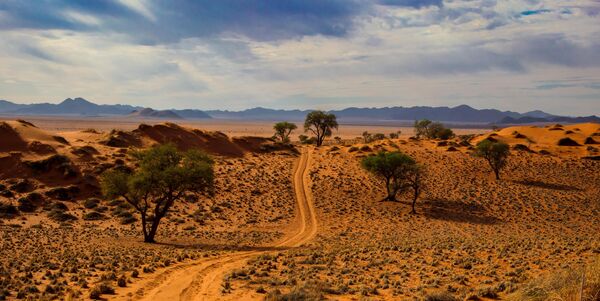Must-see places to visit in Namibia.
Brandberg

Situated in northwestern Namibia, the Brandberg (Fire Mountain) Massif is Namibia’s highest peak, at its zenith, the Königstein (King’s Stone), standing at a whopping 2573 metres above sea level.
Named for the vivid shade of orange it sometimes turns at sunset; this is undoubtedly the main highlight of the region. The Brandberg has been sacred to the San people for centuries. The Tsisab Ravine at its base is permeated with over 45 000 ancient San rock paintings, including the famous ‘White Lady’. Visitors flock here to view this unique bushman painting, said to be over 2000 years old. Other popular drawcards include its untouched natural beauty and its free-roaming wildlife, such as mountain zebra, kudu, springbok, and desert elephant.
Gobabis
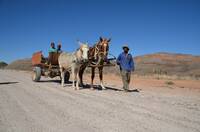
Set in the heart of eastern Namibia’s ‘Cattle Country’, the town of Gobabis is the district capital of the Omaheke region.
This town features a rich heritage and cultural diversity. It is the centre of a thriving cattle farming area and has earned the nickname the ‘Little Texas’ of Namibia.
Like most towns in Namibia, Gobabis has an interesting history, which is documented in the local Gobabis Museum. Opened on request, visitors will find a collection of historical artefacts inside, while old agricultural implements are displayed on the grounds.
Visitors can also view the beautiful traditional dress of the local Herero and Damara women while strolling through town, enjoy excellent bird watching in the surrounding areas and jump on the back of a traditional Damara-nama donkey cart for a ride. Don’t miss a visit to the Harnas Wildlife Foundation, a sanctuary for big cats and a variety of endangered wildlife.
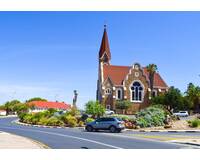
Windhoek
Situated in Central Namibia, the cosmopolitan city of Windhoek serves as the capital of the country.
It is home to an international airport and a plethora of restaurants, shops, entertainment venues and accommodation options. The city is clean, safe and well-organised, with a colonial legacy that is reflected in its many German eateries and shops and the widespread use of the German language.
Windhoek has an interesting mix of historical architecture and modern buildings, many of which are worth a look, including the Alte Feste, an old fort, the 1896 Christuskirche Christ Church, and the more contemporary Supreme Court.
Swakopmund
Set along Namibia's spectacularly scenic coast, the seaside town of Swakopmund is known for its wide-open avenues, colonial architecture, and its surrounding otherworldly desert terrain.
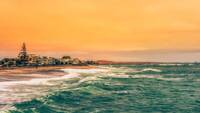
Founded in 1892 as the main harbour for German South West Africa, Swakopmund is often described as being more German than Germany.
Now a seaside resort town, Swakopmund is the capital of the Skeleton Coast tourism area and has plenty to keep visitors happy. The quirky mix of German and Namibian influences, adventure options, laid-back atmosphere and cool sea breeze make it a very popular Namibian destination. Visitors can look forward to a number of exciting activities including quad biking, horse riding, paragliding, fishing, sightseeing and fascinating desert tours.
Solitaire
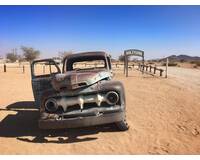
Situated in the Khomas region of Central Namibia, the desert town of Solitaire serves as an oasis in the Namib Desert.
There is not much to do or see in the small village of Solitaire, but nevertheless, it is an important stop on the way to the ancient dunes of Sossusvlei as it provides the only petrol station, general store and post office between Sossusvlei and Walvis Bay. Solitaire also has a small bar and is renowned for its famous apple pie- said to be the best in Namibia. Home to a luxury desert lodge, a motel and a campsite, visitors can easily find comfortable accommodation in Solitaire. Enjoy a scenic sundowner with views of the spectacular Namib Desert, hike and bike through the unspoilt natural scenery and visit the local Cheetah Sanctuary.
Twyfelfontein
Set in the Kunene Region of northwestern Namibia, Twylfelfontein is a spectacularly scenic area featuring one of the largest and most important concentrations of rock art in Africa.
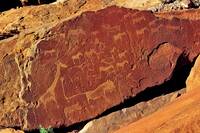
The name ‘Twyfelfontein’ translates to ‘Fountain of Doubt’, which refers to the perennial spring situated in the impressive Huab valley flanked by the slopes of a sandstone table mountain. It was this spring that attracted Stone Age hunters over six thousand years ago, and it was during this time that the extensive group of rock engravings and paintings were produced.
Visitors can look forward to basing themselves at some wonderfully shady campsites along the Aba-Huab riverbed while exploring over thirty different sites of these sacred records of ritual practices relating to traditional hunter-gatherer communities.
Damaraland
This vast desert landscape is known as one of the most beautiful regions in Namibia. Huge, untamed and ruggedly beautiful, Damaraland is an exceptionally scenic landscape featuring open plains, ancient valleys and spectacular rock formations.
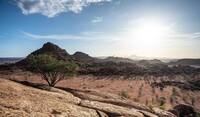
The major attractions are the sacred Spitzkoppe, the Brandberg, Twyfelfontein, Vingerklip and the otherworldly Petrified Forest.
Visitors can take in the dramatic vistas, catch a glimpse of the rare desert-adapted elephant, and enjoy spectacular stargazing in crystal-clear night skies from one of the many safari camps dotting Damaraland. Other popular activities include guided drives, nature walks and visiting the local communities. Don’t miss the opportunity to view Damaraland's world-famous ancient rock art.
Palmwag
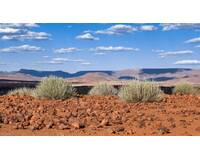
Palmwag is a nature reserve idyllically located along a palm-lined tributary of the Uniab River.
Water is scarce in this area, so the river’s presence often lures elephants closer to the camps. Palmwag is situated halfway between Swakopmund and Etosha and is the ideal base from which to see the sights of the Kunene region or embark on one of the many local hiking trails. The reserve is notable for its unusual species of palm tree, the hyphaena pertesiana, and for being home to the largest population of southwestern black rhinos in Africa.
Animal lovers can also get a peek at the leopard, lion, cheetah, mountain zebra, Angolan giraffe, springbok, kudu, and African bush elephant.
Sesriem
As there is no accommodation at Sossusvlei, visitors to this desert wilderness are likely to end up staying at Sesriem, 65 kilometres away, where camps and lodges serve as a base from which to explore the dunes.
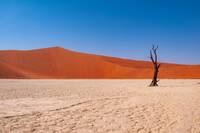
Sesriem Canyon, a deep chasm carved through the rocks by water, is a striking natural feature of the area that is best explored on foot. Stony walls rise up sharply on both sides of the canyon, while birds roost in its crags and lizards dart along the ledges. The canyon’s name was coined when early settlers used it as a water source, using six lengths of leather (‘ses riem – six thongs) tied together to lower buckets into the water at the base of the canyon.)
Caprivi Region
It forms part of the beautiful Bwabwata National Park. The park's landscape is characterised by woodlands and vast floodplains of the Okavango River basin known as Omurambas and the Kavango River. It is home to a reported 99 species, including a large number of elephants, lions, leopards and a variety of antelopes, including the red lechwe, sable and roan.
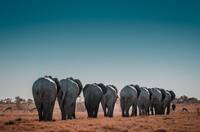
This park is an excellent destination for avid bird watchers boasting over 400 species, and provides the perfect spot for visitors to catch a glimpse of crocodiles and hippos in the Kavango River. Other popular activities include night game drives, wildlife safaris, and watching the African sunset over the floodplains.
Stretching over 6200 square kilometres in northeast Namibia, the Bwabwata National Park includes the Caprivi Game Park and the Mahango Game Reserve, which extends along the narrow Caprivi strip. The park functions as a wildlife sanctuary and practices community-engaged conservation. Dubbed the 'People's Park', the local Caprivian people live in harmony with the land and the animals. With an ever-growing wildlife population, the park is home to many animals, including elephants, leopards, lions, buffalo, wildebeests, crocodiles, as well as red lechwe.
Avid birdwatchers will be thrilled to find over 330 bird species in the area. Visitors can look forward to excellent game viewing, boat safaris, nature walks and camping under the Namibian night sky.
Etosha National Park
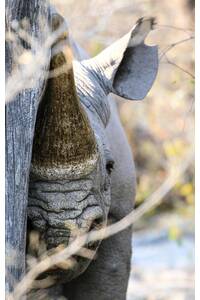
Situated in northwestern Namibia, the Etosha National Park offers a premier game viewing experience.
The park’s diverse vegetation ranges from dense bush to open plains attracting a variety of wildlife. Located in the heart of the park is the Etosha Pan - a shallow depression that covers an area of 5000 square kilometres. Dry and shimmering for most of the year, the pans fill up with water after seasonal rains, making it the perfect habitat for wildlife. In the dry season, the wildlife is attracted to the perennial springs and waterholes that make for excellent game viewing. Visitors can look forward to world-class game viewing, including a variety of large mammals such as lions, elephants, leopards, rhinos, zebra, giraffes, and a diversity of birdlife such as flamingos and pelicans.
Aeons ago, Etosha Pan was the bed of a vast lake; today, what remains is a glittering, silvery-green salt pan that stretches across roughly 5000 square kilometres. Etosha is protected by the Etosha Pan National Park, surrounded by savannah plains and woodlands supporting large herds of elephants. When dry, the pan sustains little life except for the algae that give it its distinctive colour and migratory birds that use it as a pit stop, but with heavy rain, it becomes a shallow lake where flamingos breed, pelicans wade and feed, and a variety of mammal species come to quench their thirst, including leopards, lions, white rhinos, hunting dogs and antelopes.
Mahango Game Reserve
It forms part of the beautiful Bwabwata National Park. The park's landscape is characterised by woodlands and vast floodplains of the Okavango River basin known as Omurambas and the Kavango River. It is home to a reported 99 species, including a large number of elephants, lions, leopards and a variety of antelopes, including the red lechwe, sable and roan. This park is an excellent destination for avid bird watchers boasting over 400 species, and provides the perfect spot for visitors to catch a glimpse of crocodiles and hippos in the Kavango River. Other popular activities include night game drives, wildlife safaris, and watching the African sunset over the floodplains.
The red deserts of Sossusvlei
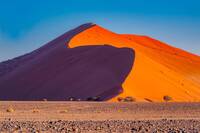
Located in the scenic Namib-Naukluft National Park, Sossusvlei is where you will find the iconic red sand dunes of the Namib.
The clear blue skies contrast with the giant red dunes to make this one of the most scenic natural wonders of Africa and a photographer's heaven. This awe-inspiring destination is possibly Namibia's premier attraction, with its unique dunes rising to almost 400 metres-some of the highest in the world. These iconic dunes come alive in morning and evening light and draw photography enthusiasts from around the globe.
Sossusvlei is home to a variety of desert wildlife, including oryx, springbok, ostrich and a variety of reptiles. Visitors can climb 'Big Daddy', one of Sossusvlei’s tallest dunes; explore Deadvlei, a white, salty claypan dotted with ancient trees; or for the more extravagant, scenic flights and hot air ballooning are on offer, followed by a once-in-a-lifetime champagne breakfast amidst these majestic dunes.
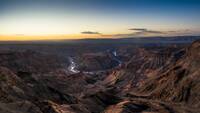
Fish River Canyon
The largest canyon in Africa and the second largest canyon in the world, the Fish River Canyon is situated in the south of Namibia and stretches for 180 kilometres (105.6 miles) from Sesriem down to the Orange River. It forms part of the Ai-Ais/Richtersveld Transfrontier Park. The Fish River Canyon features a gigantic ravine and is one of Namibia's best-kept secrets. The vegetation is sparse, but a huge type of aloe plant called the quiver tree grows in this natural wonder.
Luderitz
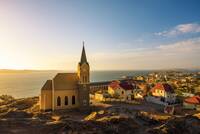
A quaint harbour town, the port is developed around Robert Harbour and Shark Island. It boasts German history, art-deco architecture and excursions to the ghost town of Kolmanskop. The colourful and unique town of Lüderitz in Namibia is perched where the rocky Atlantic Ocean coastline meets the Namib Desert. It has weathered the frenzy of a diamond rush in Namibia and the rise and fall of many fortunes over the years but kept its sleepy old-world atmosphere on this cool and often foggy Atlantic coast.
Erindi Game Reserve
Erindi Private Game Reserve is a protected reserve in Central Namibia. Erindi, meaning “place of water”, is a sustainable natural wonderland. With 70,719 hectares of pristine wilderness, Erindi has undertaken an immense task to pursue conservation initiatives in the name of eco-friendly tourism whilst empowering local communities. Today, Erindi is an idyllic retreat with a rich cultural heritage, knowledgeable guides and unmatched hospitality – ensuring visitors have the kind of safari that lives in memory for a lifetime. The reserve is home to about 20,000 animals, including various rare and endangered species.
Don't Miss... Namibia
Kalahari North
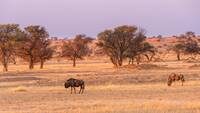
Situated east of the capital city of Windhoek, the area of the Kalahari North can be found in the northeastern reaches of Namibia.
The expansive Kalahari Desert spans seven countries, some of which include: South Africa, Botswana, and Namibia. The Okavango River Delta forms part of the northern region of the desert, creating an array of waterways and wetlands which support an abundant variety of wildlife. The northern central region is home to ancient dry riverbeds called 'omuramba'. Kalahari North is blanketed in endemic acacia- camelthorn trees, ephemeral rivers, and a fossil watercourse and boasts a reasonably regular rainfall, making it the ideal habitat to support fauna and flora. Visitors can enjoy a comfortable stay at one of many lodges and guest farms dotting the area and explore the pristine landscape.
Spreetshoogte Pass
One of Namibia’s most spectacular views is that from the top of the Spreetshoogte Pass, where the land drops off by roughly 2000 metres, creating a natural vantage point overlooking the vast, semi-desert plains and the arid mountains beyond.
Katimo Mulilo
Situated on the southern banks of the Zambezi River, the small town of Katima Mulilo serves as the capital of the Zambezi region.
This riverside town is surrounded by lush vegetation, tropical birds and cheeky monkeys. Katima Mulilo is the service centre for the Caprivi and serves as the commercial hub for the East Caprivi region. Visitors can enjoy an array of interesting attractions, including the vibrant street market, where arts and crafts, such as traditional grass-woven baskets, wood carvings, clothes and jewellery, are sold.
Keetmanshoop
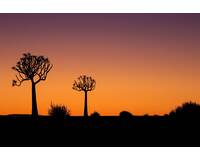
The Capital of Southern Namibia, the modern town Keetmanshoop lies approx. 500 km south of the capital, Windhoek. The town lies in the centre of Southern Namibia and on the western outskirts of the Kalahari Basin. Today it is the most important hub regarding road and rail traffic in Southern Namibia. One of the main tourist attractions in the area are the quiver tree forests. The quiver trees are mostly found on private farms and can be visited. The name derives from the utilisation of the trees’ branches by the San to make quivers for their arrows. Thirteen kilometres northeast of Keetmanshoop on the farm Gariganus we find one of the most famous quiver tree forests, which has been declared a National Monument.
Otavi Mountain Region
Visitors to this spectacular region can look forward to a variety of activities.
These include: visiting the Hoba Meteorite, the largest ‘space object’ on earth and a national monument; explore Dragon’s Breath Cave which holds world’s largest underground lake; or viewing the bottomless ‘sinkhole’ Lake Otkikoto, boasting emerald green water, one of two permanent lakes in Namibia.
Other interesting activities include hiking, biking, fishing, off-roading, and game-viewing safaris. Don’t miss the impressive Gaub Cave, filled with sensational stalactites and stalagmites.
